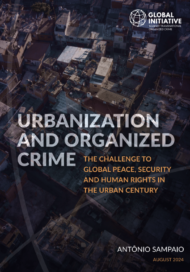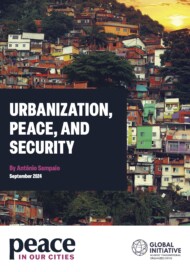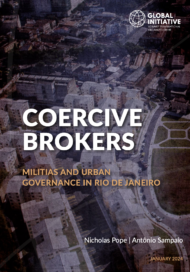Posted on 25 Jul 2025
Armed violence in our communities is a pervasive problem that has damaged public trust in institutions in countries ranging from El Salvador to Sweden. The impact of violence on people’s lives and on institutions is why countries have committed to reducing violence under Sustainable Development Goal 16, and why mayors around the world have signed a similar pledge. In the context of limited resources, it is more important than ever for governments and multilateral organizations to prioritize violence prevention as a tool for communities to improve security, particularly in cities.
Violence prevention has made important contributions to public policy and has arguably saved countless lives. However, the current patchwork of approaches based on public health, child protection, urbanism, criminology and policing innovations has overlooked the political and institutional aspects of violence prevention in favour of technical solutions. Although these approaches are extremely valuable (including investments in early childhood development, restrictions on alcohol sales, urban design improvements, gun control and data-driven ‘hotspot’ policing), they often fail to recognize the role of organized crime in driving violence.
Policies and programmes aimed at preventing violence face specific challenges when it comes to violence driven by organized crime. Tailoring violence prevention to such contexts requires practitioners to address not only the individual, family and community drivers of violence, but also the need for deeper reform of local institutions and governance models.
A global problem requiring global coordination
Latin America has long faced armed violence that is disproportionate to its share of the global population. But other regions are now also seeing a rise in criminal violence. In Europe, Sweden made global headlines as homicides spiked in 2023, and gang-related bombings struck Stockholm as recently as January 2025. In its 2025 flagship report, Europol warned that organized crime-related violence ‘has intensified in some Member States, particularly in port cities and urban drug markets’, with violence ‘encroaching upon public spaces, instilling fear and eroding trust in authorities’. The United Nations Office on Drugs and Crime estimates that organized crime caused 700 000 deaths globally between 2015 and 2021.
While organized crime’s impact and illicit flows transcend national borders, the field of violence prevention remains extremely fragmented. The predominant approach has been for local NGOs to implement modest programmes that, although impactful, often fail to scale up. One of the most effective developments in violence prevention has been the innovation and leadership of city governments, with cities such as Medellín and Ciudad Juárez registering plunges in homicides of over 80% (between 2002–2014 in the former and 2010–2015 in the latter). However, these successes are undermined by a lack of cross-regional learning and funding challenges that limit their potential for wider implementation.
Understandably, violence prevention practice focuses on replicating successful models. However, this approach can hinder innovation. For example, crime prevention through environmental design (CPTED) has enjoyed some success by proposing urban design improvements – such as communal spaces, lighting, changes to land use and surveillance – to deter crime. But these interventions have been criticized for having insufficient, or even non-existent, links to the social drivers of violence, and for focusing on fortification and surveillance.
CPTED and hotspot policing both recognize that criminal violence is highly concentrated in urban areas. This has led to approaches such as Colombia’s ‘policing by quadrants’, whereby the areas under each police station were divided into sections, enabling the police to survey detailed crime dynamics and allocate resources more effectively, leading to a reduction of approximately 11% in homicides in areas evaluated between November 2010 and May 2011. Another programme that has had an encouraging impact is ‘Cure Violence’, which was pioneered in Chicago. It uses former gang members as ‘violence interrupters’ in their communities, mediating and de-escalating conflict between gangs.
However, as a 2020 review of the evidence concluded, ‘despite successful cases of gang violence prevention programmes, there is still a significant knowledge gap on how to effectively deal with organized crime’. One fundamental challenge is devising approaches that address the modus operandi of organized crime involving the corruption of public authorities and the erosion of institutional independence. A crucial distinction can be drawn between neighbourhoods affected by local youth gangs, such as those in Chicago, and cities that host well-equipped organized criminal gangs and mafias, such as Rio de Janeiro’s militias, which have developed strong ties to municipal agencies, and Milan’s mafias, which have corrupted urban planning processes.
In the current context of increased debate over alternatives to repressive, incarceration-based models of public security, two approaches enable violence prevention to address the political and economic challenges posed by organized crime more directly: a focus on changing local institutions, and altering urban governance in territories vulnerable to criminal groups.
The first approach involves actors and agencies that have local legitimacy and are able to prosecute criminals, implement justice, mediate conflict and provide socioeconomic opportunities, thereby building trust in communities. These institutions can be formal, such as the police, courts, prosecutors, social services, religious groups, schools and NGOs, or informal, such as human rights defenders, community leaders, elders, women’s groups and small businesses. As an example of an institution-driven initiative, the mayor of Pelotas, in southern Brazil, kickstarted a project that involved mapping the main institutional actors providing services in violent communities to develop coordinated security efforts.
The second approach refers to the reality faced by many communities in urban areas, particularly in Latin America, where criminal actors set the rules – restricting people’s movements, preventing state agencies from entering the area and extorting businesses. An example of improvements to urban governance can be found in Medellín, where the ‘social urbanism’ model implemented a more equitable distribution of public infrastructure through architectural and design innovations, such as escalators to improve the mobility of residents in low-income hillside settlements and public libraries to provide safe spaces for young people to socialize. Unlike CPTED, which focuses on small-scale, localized interventions, ‘social urbanism’ altered infrastructure on a large scale, improving entire communities’ access to economic opportunities and enhancing the state’s capacity to enforce the rule of law.
With the global urban population forecast to grow by 2.2 billion by 2050, it is clear that urban institutions and governance will continue to play a critical role in strengthening the rule of law. Together, these two pillars can provide a robust foundation for prevention strategies that address more serious types of criminal violence, moving beyond technical approaches and avoiding morally questionable, repressive securitization.
Although the primary responsibility for addressing these challenges rests with governments, an independent Track 2 process can provide food for thought to stimulate new policy approaches. The GI-TOC’s Mesoamerican Working Group on Security and Democracy is being convened as a high-level, non-governmental forum that will develop evidence-based responses to violence and citizen insecurity caused by organized crime in the region. The group will bring together current and former heads of state and other office bearers from the region, alongside experts from academia, the private sector and civil society. It will promote an actionable agenda of recommendations to prevent and combat violence, organized crime and insecurity in the region within a framework that respects democratic norms. The group first convened in an event in June 2025 in Washington DC.



